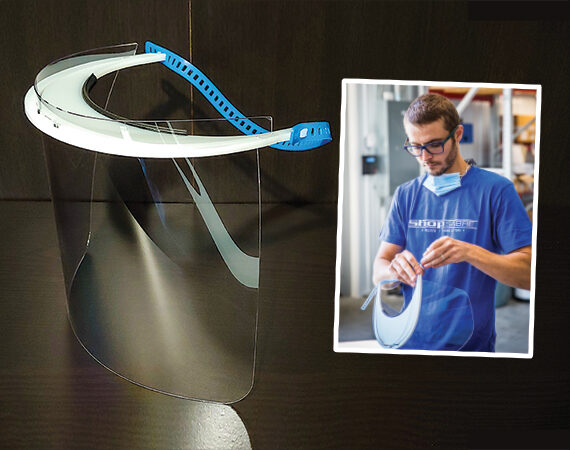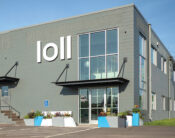From that single Facebook post, within two days, the company was making products. Four months later, around 90,000 units were on their way to 40 states and three countries — and more are coming.
As Lucas Hoffman and Marco Fenu watched the COVID-19 economy reduce the work orders at their Detroit Lakes-based industrial engineering company earlier this spring, Fenu kept thinking about his mother, a doctor on the front lines of Italy’s attempts to fight the coronavirus. Her country’s chronic shortage of personal protective equipment (PPE), she told him, hindered her efforts at every turn.
In the four years since Hoffman and Fenu launched InLine Motion to design and manufacture conveyance equipment for the food processing industry, the two engineers/entrepreneurs had harvested impressive success. Increased growth already had prompted the company to move three times in search of larger facilities.
But they wondered about taking a detour into the production of PPE-related face shields. They had the capacity. They had the time. And they recognized they could likely produce protective face shields without a significant upfront financial investment or having to retool their equipment. But how many should they make? And who would want them?
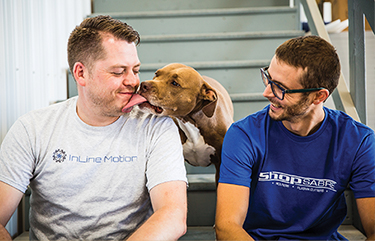
“We didn’t want to spend a bunch of money, make a whole bunch of stuff, and then not have anybody even be interested in them,” Hoffman says.
So, at about 6 p.m. on Thursday, March 26, they posted a Facebook inquiry to gauge market demand for medical-grade PPE plastic shields.
“We are able to design and produce face shields, but we do not know where we should send them,” the post said. “We are seeking health care facilities in need that are accepting donations. Please help us get in contact with the right individuals by liking and sharing the post!”
In about the time it took for Fenu to make the 20 minute drive from the company’s 4,800-square-foot facility just west of Detroit Lakes to his home in Hawley, the post already had generated a whopping 4,000 pageviews. By 11 p.m., it had more than 20,000 views, with responses from New York to Thailand to Zimbabwe.
“That’s viral,” Fenu says, “at least for us it is.”
Hoffman still marvels at the quick magnitude response. “I don’t understand how it got out so fast, but people were sharing it,” he remembers. “We knew there was something big here.”
They soon found out how big. About four months after the initial Facebook post, their new subsidiary, InLine PPE, had leveraged the help of other Minnesota companies to produce almost 90,000 high-quality, easy-to-assemble, reusable face shields for health care customers in 40 states and three countries. And to add a little made-for-TV drama, just before Hoffman and Fenu were to deliver their single biggest delivery of face shields to their most consequential customer, a crucial supplier temporarily ceased operations. Riot-related arsonists had burned down a neighboring building, and the supplier didn’t yet feel safe restarting operations. More on that later.
Following their inquiry’s response that first night, the two engineers merely knew they had stumbled upon an intriguing diversion. Working separately from their homes, they turned off their phones and convened a Webex video conference to collaborate on their first prototype. A quick web search revealed that many existing products appeared cheaply made or required unnecessary assembly.
“We saw what we didn’t want to do,” Fenu says.
So, they started from scratch. Beginning by cutting up paper plates, they fashioned prototypes they hoped would adjust comfortably and easily to the different sizes and shapes of the human heads that would likely be wearing them for long periods.
Finally satisfied with the first night’s model, they went to bed, but not before Hoffman drove back to the office to program their printer to ensure a 3D version would be ready when they arrived the next morning.
Yet when they examined that first prototype, they didn’t like it. Not enough comfort. Hoffman and Fenu didn’t like the next one, either. Or the next one. All through the day, they tweaked programming changes into their CNC router — faster than the 3D printer — and produced 22 varieties of the face shield before they settled on the model they wanted to manufacture.
This focused, quick-turnaround attention to detail reflects the work ethic the two business partners used to build InLine Motion. Both graduates of North Dakota State University, Hoffman and Fenu met while working as engineers at Friesen’s Inc., another Detroit Lakes-based designer and fabricator of food processing equipment.
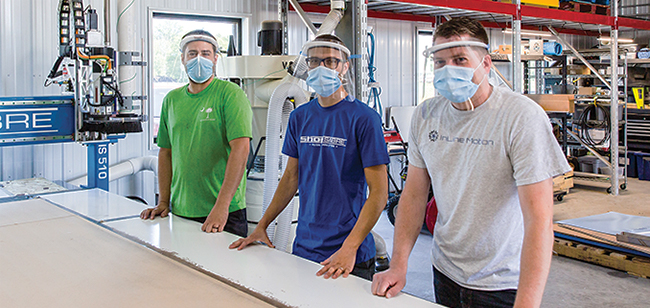
Hoffman, 38, originally a North Dakotan, had worked at Friesen’s for 12 years, the last 18 months as an engineering manager. Fenu, 28, arrived in Detroit Lakes through a more circuitous route. A native of Cagliari, Italy, he spent his junior year as an exchange student at Wayzata High School in the Twin Cities; after completing high school in Italy, he immediately returned to the U.S. and enrolled at NDSU. His job at Friesen’s was his first out of college in 2014.
Hoffman and Fenu shared a vision that their market niche was ready to embrace an innovative company that emphasized engineering over mere fabrication.
“A lot of the companies in this space are basically fabrication companies that have engineers, versus engineering companies that can do fabrication,” Hoffman says.
While old-school fabricators tend to produce equipment at their clients’ specs, he continues, the InLine approach identifies a problem, designs a solution, and then builds it. Fenu and Hoffman pooled their resources in 2016, bought the essential computers and high-tech software, and opened the doors of InLine Motion. Their concept included design software that could create 3D models and robotics to help clients address processing conveyance issues efficiently and reduce complexity.
They marketed their company with the confident assumption that while food is a massive domestic industry, it consists of a relatively small and interconnected community.
“People know each other, they work with other companies, they move on to other companies,” Hoffman says.
They already had a good network they could leverage. The two partners hit the trade show circuit and came home with a satisfactory level of new business. The company took off. One single early order accounted for 40 percent of the revenue projected in their business plan.
Attracted by InLine Motion’s high-tech expertise, customers warmed to their design/build concept. Their ability to use software to project a holographic display of their 3D system that clients can see and literally walk around invited return business. Soon, Fenu says, “the people were starting to find us, versus us having to go out and find them.”
InLine Motion’s momentum experienced a hiccup in March, however, when COVID-19 uncertainties assaulted its order books and upended growth. Fenu acknowledges the company’s workload dropped to just one significant project at the time of their Thursday Facebook post, with nothing else in the queue.
Which explains why the company saw value in the PPE diversion and moved quickly to make it operational.
With a satisfactory prototype in place that Friday, the InLine Motion partners started to research and procure materials they could use to produce shields during the following week. They planned to produce a three-piece unit that could be shipped flat and that end users could assemble and adjust to wear in less than a minute. Their list of materials included a sturdy transparent material for the shield (“the clears”), something to make up the adjustable headband that would affix to the shield (“the halo”), and a piece of equipment that would effectively ensure a tight fit (“the backstrap”).
They considered two options for the clears. Transparent polycarbonate, a material 250 times stronger than glass that builders and engineers frequently use in shower doors or safety shields, seemed readily available. But they eventually preferred PETG (polyethylene terephthalate glycol), a thermoplastic material that would be simpler to cut, easier to clean and just as resistant to scratches. It was also available.
For the halo, they agreed on high-density polyethylene (HDP). The InLiners scoured the local home improvement stores — all the way up to and including Fargo — to procure every sheet of HDP they could find for their first production run. The back straps consisted of sports straps that athletes use to keep their glasses from falling off during competition. Not a large market.
“We actually bought out the country on the sports straps,” Hoffman recalls. And then, when the partners discovered that most straps were manufactured in Taiwan, “we cleaned out Taiwan.”
“That’s Friday,” Hoffman says, as in less than 24 hours from the Facebook post. “We had enough material coming in early the next week to make 6,000 shields.” They started producing shields in-house the next day using their CNC router.
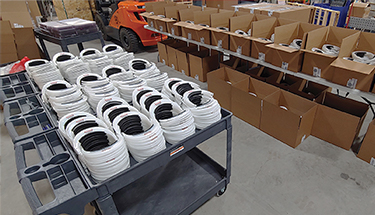
But to create enough shields to fulfill the steady stream of inquiries and orders, Hoffman and Fenu recognized they would need production partners.
“We realized where we were at and what the demand was going to be,” Hoffman says. “We started asking, how can we do more? How can we improve?”
They wanted to find partners who could “cut the clears” and use injection molding to manufacture the halos.
For the shields, they contracted with Broadway Welding Inc., a nearby company that, although quite busy, had the capacity on their laser cutter, Fenu says. “They were happy to jump on it.” To manufacture the halos, they turned to Twin Cities-based Protolabs. To accommodate marketing and sales, they had Hoffman’s brother Joe create a new website in just a day.
Hoffman and Fenu also knew the company would need in-house capacity to fulfill orders coming in for lots as small as 10 shields. So, InLine beefed up staffing from the two partners and their two employees to using up to 10 temps. “They were pretty easy to train, so we’d get somebody out in the morning, and they’d be at full speed by the end of the day,” Fenu says.
But before committing to any delivery times, their “inner engineers” told them not to let the adrenaline rush of administering incoming orders overpower their ability to develop orderly procedures. They decided to withhold any shipments for a week and focus only on building up inventory.
“That was one of our best decisions,” Fenu says. “We didn’t want to overcommit. We could have been overwhelmed right away because we hadn’t figured out the processes and logistics. We needed to get that all figured out before we could commit to start shipping.”
The streamlined process enabled InLine to fulfill all its orders by the following Friday while maintaining a stockpile of products.
During that first week of production, the InLine PPE team got a call from the Veterans Affairs office in St. Cloud, prompted by the Facebook post. How many can you make, they asked, and how quickly can you ship them?
“They placed an order right away and told us they would send our information to VA offices in the area,” Fenu recalls.
Soon after that, they got an inquiry from the Bloomington-based regional office of the VA, which sought shields for its entire Midwest region. The facility already had received some InLine PPE face shields. The VA rep told Fenu that health care workers preferred the comfort, durability and high quality of the InLine PPEs to the competition, especially the fact that replaceable “clears” made them reusable.
The VA requested 15,000 kits, and another 30,000 replacement “clears.”
Although newbies to navigating the complicated maze of bureaucracy related to federal procurement contracts, Hoffman and Fenu survived the process with the help of a consultant skilled in the art of filling out government forms.
The VA order almost didn’t get filled. To keep up with the growing demand for their faceguards, InLine PPE contracted with several companies around the state to cut the PETG material and return it to Detroit Lakes for final assembly. A week before the VA shipment was due, a large supplier in Minneapolis reneged on its agreement. Protesting arsonists, it seems, had burned down a filling station next door and worries arose that the fire would spread. The company, out of caution, temporarily shut down.
“At that point, there was a little panic, obviously,” Fenu admits. “We started deploying all the different people that we could find to move all the material in that company to another facility that was safe.” Most of it, he says, was relocated to a safer site in St. Cloud, “where there weren’t any riots.”
InLine PPE completed the massive order just under the deadline, but it didn’t matter. The VA itself was unable to receive the shipment because of the same turmoil in Minneapolis.
Hoffman says all this short-term success in medical manufacturing will not divert the partners’ attention away from the food conveyance marketplace — the reason they founded their company.
The face shield market, he says, “is going to go away at some point. We might keep making a few here and there, but obviously nothing to the extent that we’ve seen recently.”
Their mission, he says, will be to find lessons in the PPE project that will improve their core business. The most significant experience, he continues, was seeing how e-commerce will help InLine Motion improve its operation as it transitions back to its core business.
“This experience opened up our eyes to the value of an e-commerce website,” Hoffman says. “It can actually produce money, versus just give you the ability to try to go sell something. Personally, I like looking at my phone and seeing how much money we made for the day.”
…
Featured story in the Fall 2020 issue of Enterprise Minnesota magazine.
